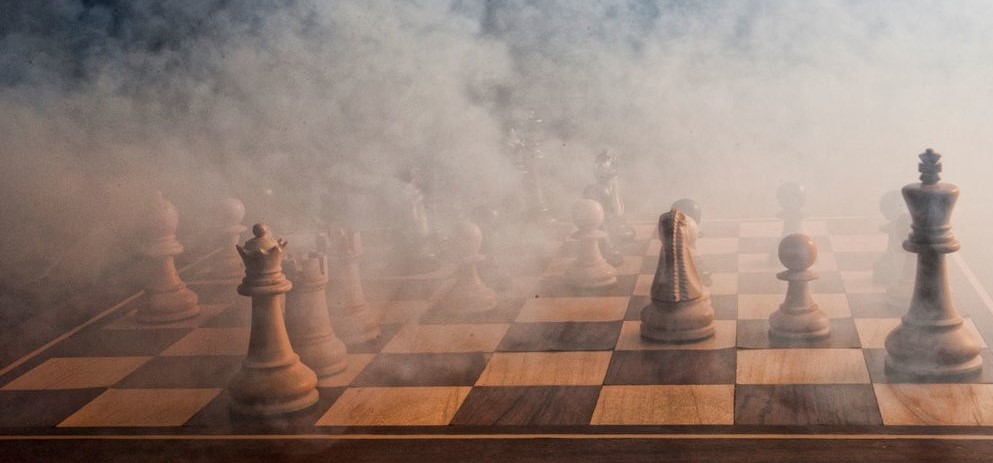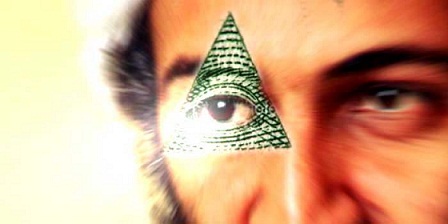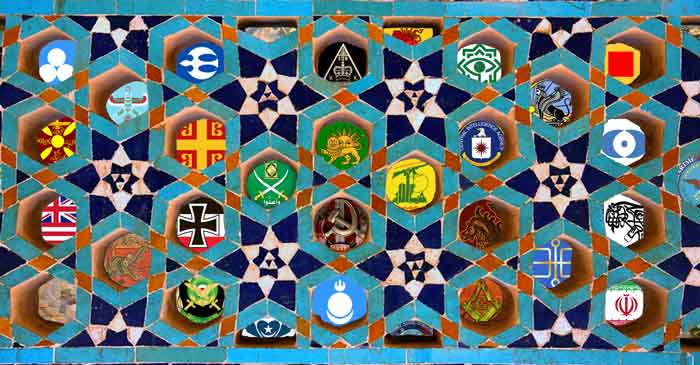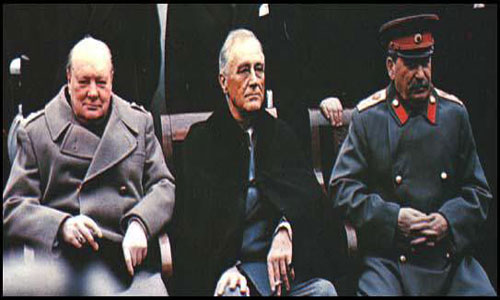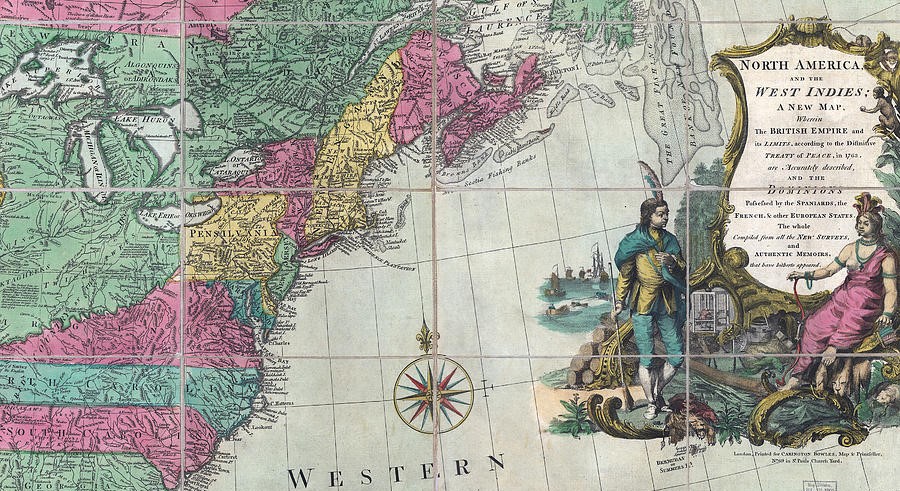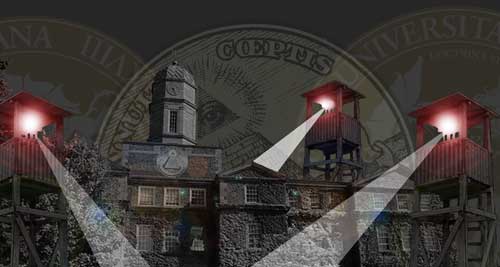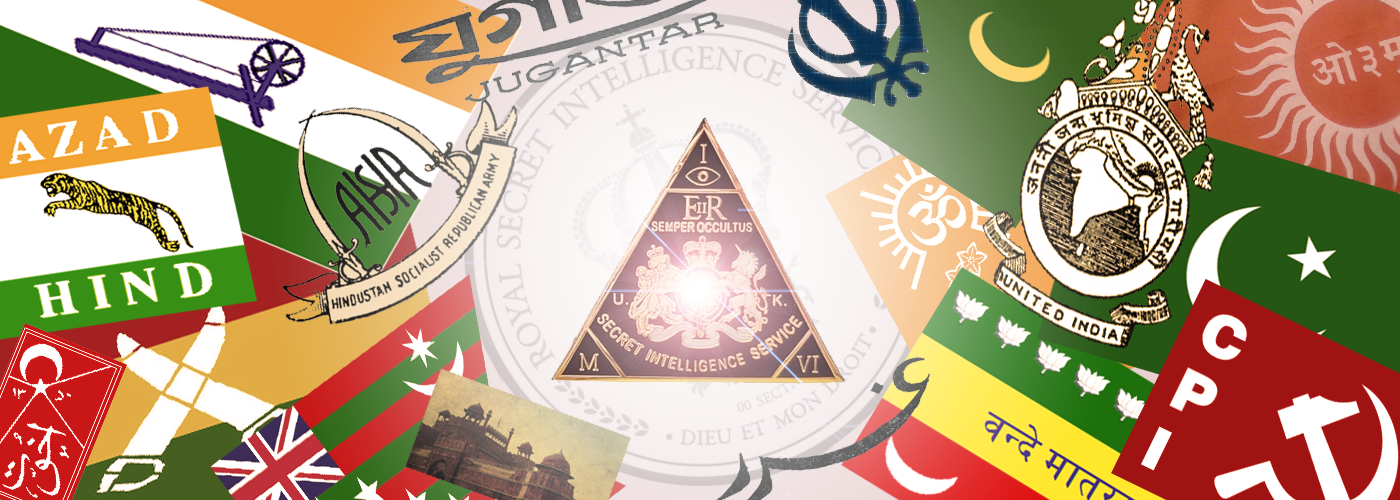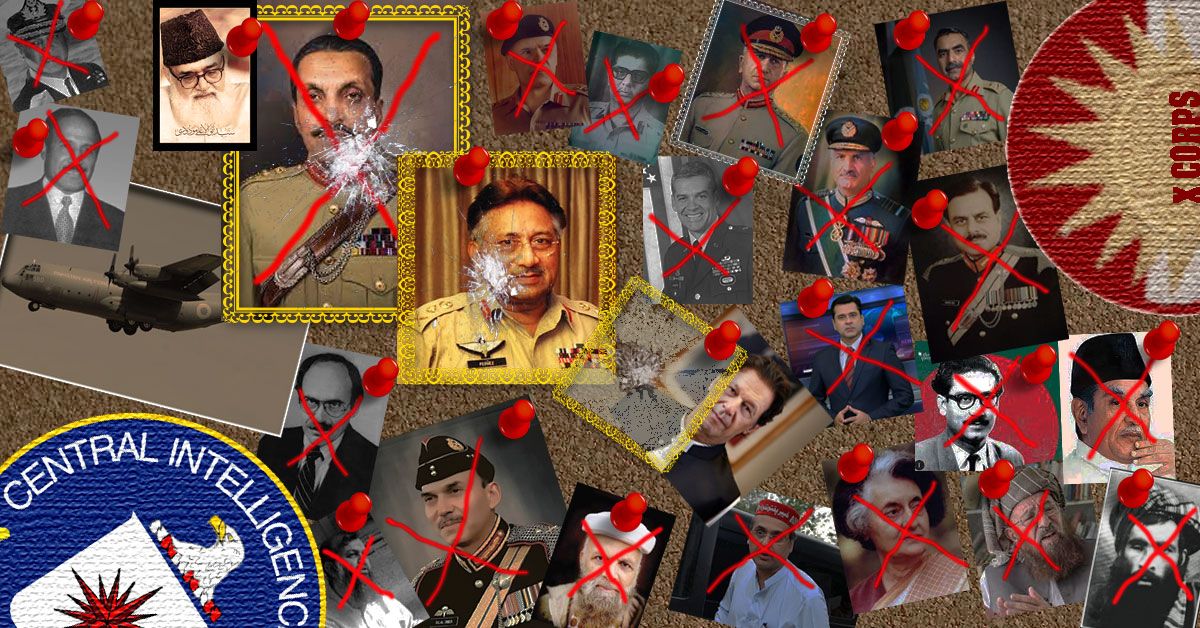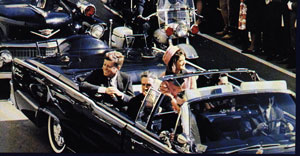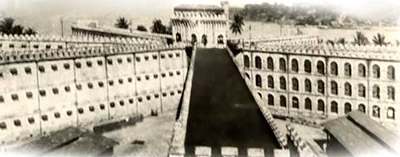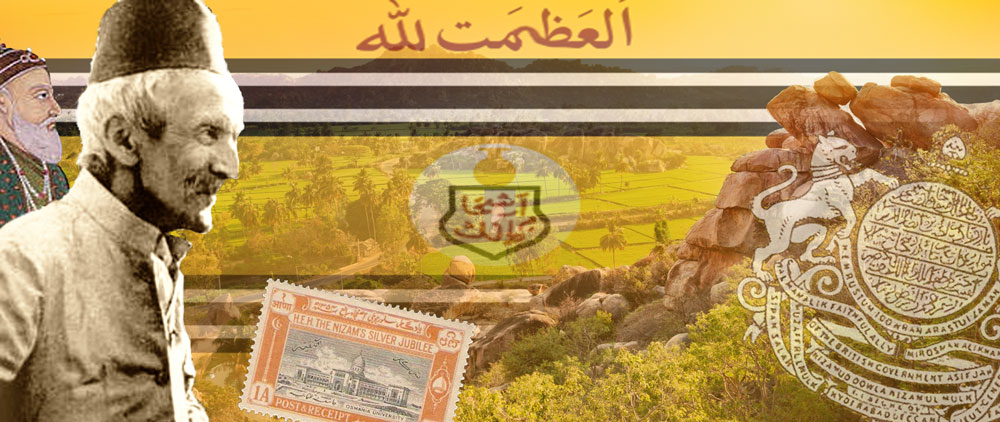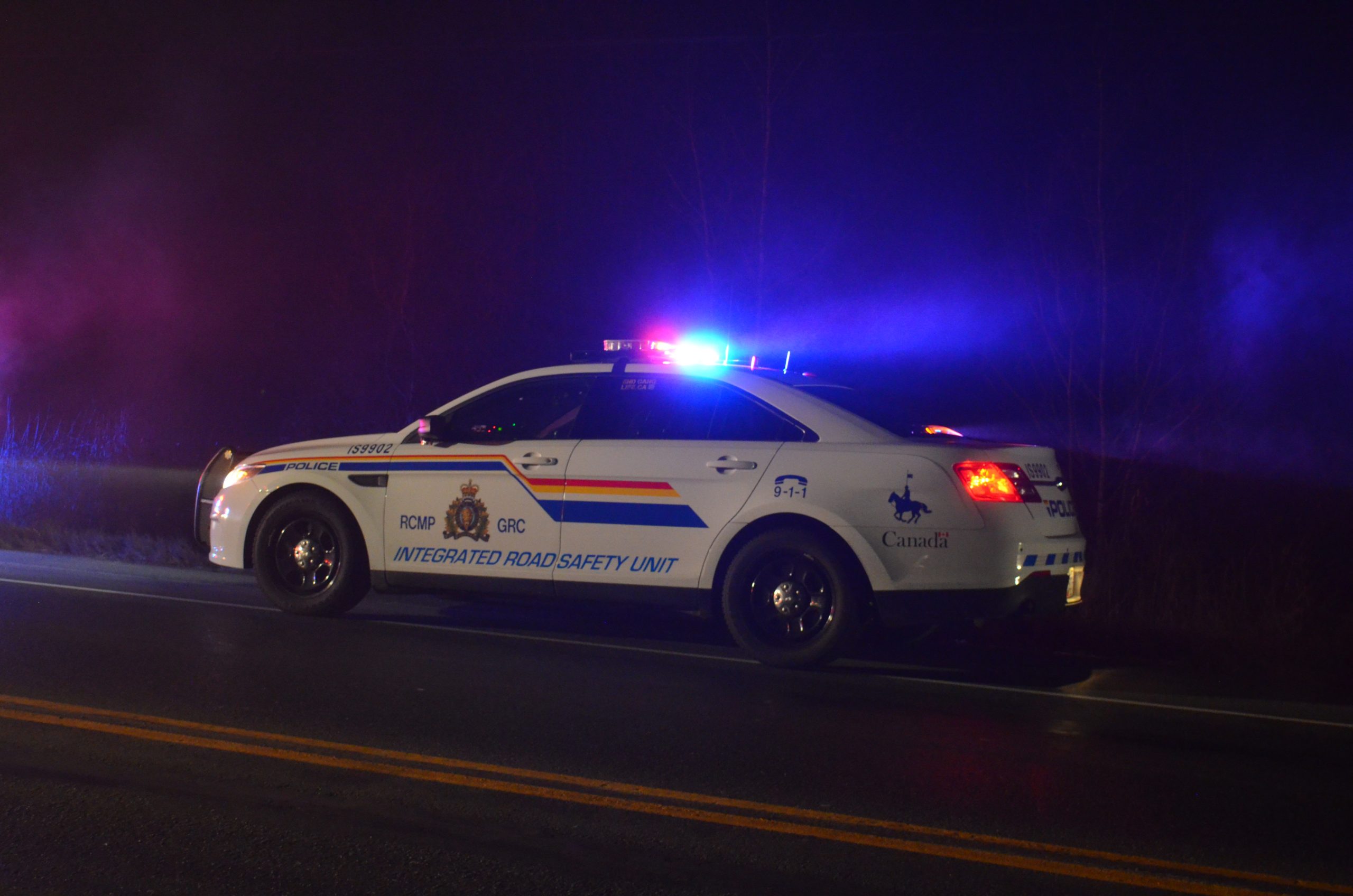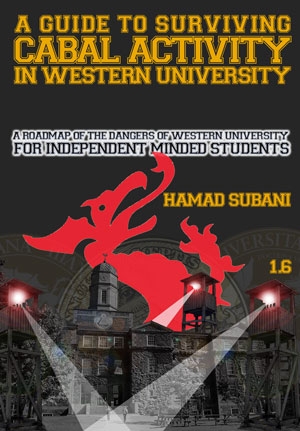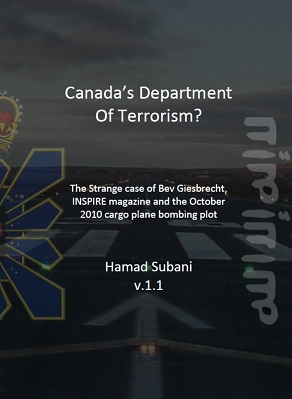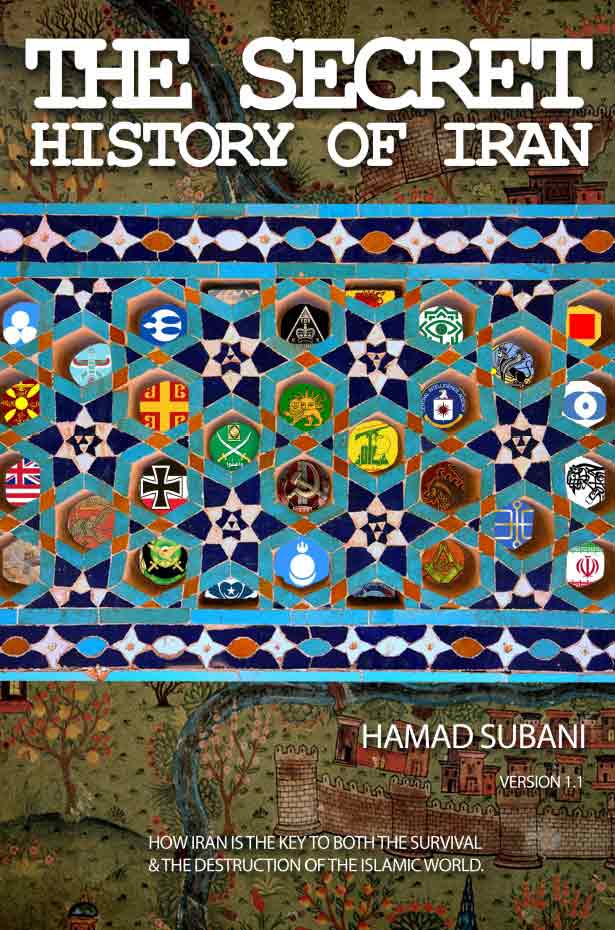
The 1857 Project as a Spook Playbook for later Ops in the Subcontinent
When the Phoenicians decided it was time to wrap up their “British Empire,” another “Freedom” project was launched on the lines of the 1857 Project. Like 1857, huge violence and destruction was planned. Not just in North India, but this time throughout the Subcontinent. And this time, the British colonists would be more at the recieving end of the violence. This violence would allow the Phoenicians to destroy several groups of people, as well as all emerging non-Phoenician leaders. In the end, the chains of British rule would get substituted with those of atheistic Communism, which the people of the Subcontinent would be duped into accepting as their glorious “Freedom.”
It comes as no surprise that this new “Freedom Movement” project would be openly modelled on the 1857 project. An acorn does not fall far from its tree.
It comes as no surprise that this new “Freedom Movement” project would be openly modelled on the 1857 project. An acorn does not fall far from its tree.
V.D. Savarkar’s 1909 Book on 1857; a Spook Project on a Spook Project for an Upcoming Spook Project

V.D. Savarkar (1883-1966) was a key figure behind (and in between) several “Freedom Movements” that popped up in the Subcontinent around World War I. He came from a community of Chitpavani Brahmins, who are of Jewish origin.
We are told that Savarkar devoted many years of his life to researching and writing a book on the 1857 Rebellion. We are told he wanted to use the “1857 Rebellion” as a template for the upcoming “Freedom Movement.” The problem was that most Indians had forgotten about it. And the new literate class of India could only read English (and were therefore restricted to cartoonishly biased English sources). And therefore a “local” book in English on the subject became necessary.
It seems Savarkar had access to libraries and materials across Europe, and the British didn’t seem to have any problem with that. To quote,
Savarkar got down to digging out the vast material lying in the British museum and the India House Library and the published and unpublished information scattered at various places in Europe. Savarkar was under constant vigil of the British. But such was the enthusiastic fervour of this hero that inspite of it, he was able to collect and collate material with single-handed devotion.
[…..] […..] in his authenticated book, written originally in Marathi, and translated into English as The Indian War of Independence of 1857. The first English edition was published in Holland despite intensive surveillance by the British authorities to prevent its publication and circulation.[…..] It became a Bible for the revolutionaries ran through many editions. [1]S.N. Agarwal. The Heroes of the Cellular Jail Rev. Edition (New Delhi: Rupa) 59-60.
How did a watched and followed “Freedom Fighter” on British soil manage to get access to material in the British Museum? And what exactly was he doing in London?
Or was the book ghostwritten in London and elsewhere, and Savarkar was one of the many editors/contributors? (and maybe he did contribute a few chapters on Maratha players in the 1857 project, as that was his expertise). Later, I will point out an unmistakable connection to the Spookopolis of Bhopal, whose ruling elite may have also been involved with the production of the book. For the sake of simplicity, we will assume that Savarkar is indeed the author throughout this series.
A Marathi version (or translation?) was first released, maybe to make it appear like a local work. This makes no sense because all the sources used are English ones, not Marathi ones. We are told that the English translation was prepared later “under the supervision of” V.V.S Aiyar,[2]S.N. Agarwal. The Heroes of the Cellular Jail Rev. Edition (New Delhi: Rupa) 107. who hung out with Savarkar in London.The English translation I am consulting is written by “AN INDIAN NATIONALIST,” and the Publishers identify their location as London and the year of publication as 1909. The books used as source material are exclusively English language books, by British authors. No local Indian sources are used.
The Relevance of Savarkar’s Book
Regardless of who wrote the book, it is still relevant as an important source of information regarding the 1857 Project. Back when it was released, it contained a lot of new information about freedom fighters that had long been forgotten from the collective memory of the Subcontinent. Remember that most of the Subcontinent was illiterate, and now those that were literate were working for the British.
The book is still relevant now for Conspiracy Researchers, for the following reasons,
- This book is a treasure trove of hard to find information. Simply because there are way too many Freudian slips that escaped the final edit. It seems both British and Indian Spook-authors/editors had gathered in London to ensure consistency. But remember that it was written at a time when Spooks had no means to collaborate online using Microsoft Teams® and the authors/editors were hard pressed to rush it to print before the 52nd Anniversary of the Rebellion. Editing and re-editing a typed up manuscript is laborious (There were no Word processors back then). And again, the intended audience, the Indian people of that time, would have never noticed the Freudian slips. Most were illiterate. Those that were literate were literate in English (and were busy working for the British), which means they had only read cartoonish British narratives (if they had any interest in history).
- The book contains inside information that could have only come from top-level Spooks involved in the 1857 project! When such information is presented in the book, it is artfully dispersed in a manner that it is difficult to judge where it came from (Savarkar or the British authors he cites?). Many such pieces of information were kept secret from Indian commoners until then. The inclusion of this was intended to give the book credibility and appeal.
- A critical reading of the book, with the assistance of newly discovered information, helps decode what the authors wanted to coverup with respect to the 1857 project (For example, certain questionable rebel leaders have entire chapters devoted to them to misdirect). A lot of coverup is accomplished by downright omission. New research also helps uncover what the book deliberately omitted.
- A critical reading of the book, with the assistance of newly discovered information, helps decode what the terrifying future of post-British India was to be like, had the new “Freedom Movements” affiliated with Savarkar succeeded.
In the book, a lot of cryptic hints are dropped that the true purpose of the Rebellion of 1857 was hidden. To quote,
In all great religious and political revolutions, it is almost impossible to connect together links apparently inconsistent, without thoroughly understanding the principles which are at their root. On seeing a great work of machinery composed of innumerable screws and wheels doing work of tremendous magnitude if we do not understand how the power is produced, we may feel bewildering astonishment, but never the inner pleasure due to knowledge. When writers describe such stirring events like the French Revolution or the religious revolution of Holland, the very splendour and magnitude of the crises they paint, often, dazzle and confuse their mind’s eye and they rarely gather sufficient coolness and courage to go deep into the underlying principles. [3]An Indian Nationalist (Later attributed to Vinayak Damodar Savarkar), The Indian War of Independence of 1857 (London: Unknown 1909).p 3
There is a subtle reference to Satanic ritual sacrifices, which Phoenicians are very into since antiquity. These were used to summon Djinns. The analogy implied is that the Rebellion was one such sacrifice. To quote,
[……] so offerings must be thrown in the Sacrificial Kunda (pit) until the presiding deity appears in person. [4]An Indian Nationalist (Later attributed to Vinayak Damodar Savarkar), The Indian War of Independence of 1857 (London: Unknown 1909).p 56
And elsewhere, we find an unmistakeable reference to staged, fake events, created by actors. There is even a reference to another earlier fake Rebellion in Vellore, which was used as a test phase for the upcoming Rebellion of 1857! This fake Rebellion was conducted to deport the family of Tipu Sultan from a palace in Vellore (they were being kept there under house arrest) to the faraway British Spookopolis of Calcutta, where they ended up on the streets, pulling rickshaws. This was necessary because even without Tipu Sultan, the family was commanding respect and affection of the locals. To quote (emphasis mine):
Just as in a theatre, before the actual performance, several rehearsals have to be gone through, so in history, before the actual and final attainment of freedom, in order to harmonise the whole performance, several rehearsals in the shape of risings are necessary. In Italy, the rehearsals started as early as 1821, and only in 1861 was the play successful. The Rising at Vellore in 1806 was such a rehearsal on a small scale. In this rising, the sepoys had been won over by the princes and people. At markets, preachers disguised as Fakirs were preaching. To indicate the time of rising, chapatees even had been distributed. Hindus and Mahomedans together had risen in the name of religion and liberty. But this being the first rehearsal, they fell even as they were rising. Never mind! Before the final performance how many rehearsals have to be gone through! Only the actors should boldly stick to their tasks and never cease their rehearsals. And for producing this drama, both England and India were working day and night without rest.And those that were making ready to take part in the play were not common, poor, or ignorant folk. The Gadi of Tanjore, the Masnad of Mysore, the Raigarh of Sahyadri, the Dewan-i-Khas of Delhi were among the select actors. And to crown all. Lord Dalhousie landed on the shores of Hindusthan in 1846. There is not now much time left for commencing the task which was sworn to on the battlefield of Plassey.[5]An Indian Nationalist (Later attributed to Vinayak Damodar Savarkar), The Indian War of Independence of 1857 (London: Unknown 1909).p 14-15
The Authors of the MYSTERIOUS 1909 Book, The Indian War of Independence of 1857.
The chapatees along with lotus flowers, would be reused in the 1857 Rebellion.[6]An Indian Nationalist (Later attributed to Vinayak Damodar Savarkar), The Indian War of Independence of 1857 (London: Unknown 1909).p 79
Note that he mentions the Dewan-i-Khas of Delhi, and not the Emperor himself. This confirms that the Emperor was surrounded by Spooks. Tanjore and Mysore (which had a Phoenix on its official seal) have been ruled by Phoenicians, and it’s hard to picture them participating in the Rebellion. But they could have been involved in the planning. Raigad district is the home turf of Jewish-origin Chitpavanis, including Savarkar. No surprise to see them in the planning of the Rebellion.
And just 33 years (note Spook marker) prior to the 1857 Rebellion, we are told that the British had “suppressed” a similar staged sepoy mutiny at the very same town of Barrackpore, where the 1857 Rebellion later originated from!
Savarkar also hints at secret leaders who were organizing everything. To quote,
Though all political and religious wrongs were explained and commented on to the lowest Sepoy in the army, though every Sepoy knew about, and was anxious for, a fight with the English, still the knowledge of how to rise, when to rise, and who were the leaders of the various groups was not imparted to all. The work of deciding all these things was left to the oficcers, and every one was made to swear either by the water of the Ganges, or by the leaf of Tulsi, or on the Koran, that each one would do what the regiment should undertake to do. [7]An Indian Nationalist (Later attributed to Vinayak Damodar Savarkar), The Indian War of Independence of 1857 (London: Unknown 1909).p 74-75
[…….]The English afterwards gathered a good deal of material to determine what this organization was, and Mr.Wilson gives the following information about the society, in the Government report: “From the available evidence I am quite convinced that the 31st of May, 1857, had been decided on as the date for simultaneous rising. Every regiment had a committee of three members; and this committee used to do everything connected with the Mutiny. The Sepoys had no idea what decisions were arrived at. The mutual agreements between the various regiments simply amounted to agreeing to do what the other regiments would do. The committee had to decide on all important-schemes, to do all the correspondence, and several other things.[8]An Indian Nationalist (Later attributed to Vinayak Damodar Savarkar), The Indian War of Independence of 1857 (London: Unknown 1909).p 74-75
Such an arrangement would indeed be beneficial to the Phoenicians, if the planners were in fact “British,” as they had to be completely hidden from the British soldiers, lower level officers and British commoners. In fact, we see this arrangement again in later “Freedom Movements” in the Subcontinent that were keen on violence.
The author(s) of the book do dismiss[9]An Indian Nationalist (Later attributed to Vinayak Damodar Savarkar), The Indian War of Independence of 1857 (London: Unknown 1909).p 6 cartoonish British theories which were later spread in India. Such as the Rebellion being solely caused because of cartridges greased with cow fat, or that it was caused because of the annexation of Awadh State by the British. It seems that these tropes were later exaggerated to fool commoners in both Britain and the Subcontinent.
But in all 444 pages of the book, not once do the author(s) raise the possibility that the Rebellion itself was a British op. Instead, they goes above and beyond trying to sell the Rebellion as a genuine “Revolution” of the Indian people, based on Swadharma and Swaraj![10]An Indian Nationalist (Later attributed to Vinayak Damodar Savarkar), The Indian War of Independence of 1857 (London: Unknown 1909).p 7.
But in all 444 pages of the book, not once do the author(s) raise the possibility that the Rebellion itself was a British op.
Savarkar’s Favourites

He was inclined to embonpoint; his face was round; his eyes, restless like those of a tiger, were piercing and of great lustre; his complexion was like that of any Spaniard; his conversation was characterised by a touch of humour. [11]Quoting Sir George Otto Trevelyan, Cawnpore, pages 68—69. Edition unknown. An Indian Nationalist (Later attributed to Vinayak Damodar Savarkar), The Indian War of Independence of 1857 (London: Unknown 1909).p 31
–A British baronet making an inside joke about Nana Sahib’s (and the Maratha Peshwas’) non-local origins. But it was deemed too revealing and seems to have been excised from all later editions of his book.
Savarkar heaps praise and adulation for some fellow Chitpavani-Marathas (who could be his distant cousins), He goes to great lengths to portray them as authentic, sons of the soil. He also bats for some Deshastha brahmins, Karhade brahmins and other mysterious characters. Some of the people he propagandizes are:
- Nana Phadnavis,[12]An Indian Nationalist (Later attributed to Vinayak Damodar Savarkar), The Indian War of Independence of 1857 (London: Unknown 1909).p 14 a Machiavellian Chitpavani Brahmin who intrigued and conspired against the Mughals long before 1857.
- The rebel leader Nana Sahib (Chitpavani Brahmin): The Peshwa preceeding Nana Sahib, Baji Rao II, was an open collaborator with the British, and even received a nice pension from them later in his life. It is actually surprising to see Nana Saheb emerge as a rebel leader. Savarkar does his best to defend Nana Sahib’s unnecessary massacres of European civilians at Kanpur.[13]An Indian Nationalist (Later attributed to Vinayak Damodar Savarkar), The Indian War of Independence of 1857 (London: Unknown 1909).p 193, 252. In fact, he also defends Nana Sahib in his later memoirs. Was Nana Sahib an ancestor? Savarkar of course, does not question Nana’s strange disappearance after the Rebellion.
- The rulers of the rebel Jhansi state (Karhade Brahmins): Two big chapters are dedicated to Jhansi. Savarkar tries to rationalize Nana Sahib’s great assistance to the Rani of Jhansi (at a time when his rebel armies were desperately needed in North India) to childhood bonds with the Rani.
- Rebel leader Tatya Tope (Deshastha Brahmin).
- Rebel leader Azimullah Khan: A mysterious Muslim who was the right man of Tatya Tope, and who also spent time in Europe (prior to the 1857 Rebellion) hobnobbing with British Spook families. It seems he was adopted from a starving Muslim family because of his unusually good looks. He could have been a playboy for both male and female Phoenicians, in both Europe and India. Just prior to the Rebellion, Nana Sahib and Azimullah Khan personally visited almost all British cantonments in North India,[14]An Indian Nationalist (Later attributed to Vinayak Damodar Savarkar), The Indian War of Independence of 1857 (London: Unknown 1909).p 79 Note 2 without arousing suspicion. It seems like they were being paraded and established as leaders of the Rebellion in advance, by making the sepoys familiar with them. Like Nana Sahib, Azimullah Khan later disappears in Nepal.
- Savarkar completely hides the role of the traitorous Kashmiri, Hakim Ahsanullah Khan, and his role in convincing the last Mughal Emperor to leave the confines of the safety of his fort. Instead he attributes this move to Bakht Khan and a traitor prince named Mirza Ilahi Baksh.[15]An Indian Nationalist (Later attributed to Vinayak Damodar Savarkar), The Indian War of Independence of 1857 (London: Unknown 1909).p 279-280
- Savarkar tries to portray the the last Nawabs of Awadh (Begum Hazrat Mahal and Birjis Qadr) who were placed on the throne in Lucknow by the “rebels” (because Wajid Ali Shah was being held in Calcutta) in a positive light.[16]An Indian Nationalist (Later attributed to Vinayak Damodar Savarkar), The Indian War of Independence of 1857 (London: Unknown 1909).p 283 These were in fact crypto-Jews of Iraqi origin who were closely coordinating with the British. For example, Begum Hazrat Mahal actually arrested and detained the charismatic fighter Moulvie Ahmed Shah because he was getting too popular. He was only released after all the rebels threatened to withdraw their support of the Begum. Many of this Moulvie’s plans were deliberately sabotaged from within. Savarkar of course, does not draw attention to the strange relocation of Begum Hazrat Mahal and Birjis Qadr to a palace in Nepal after the Rebellion.
Miscellaneous Spookery in Savarkar’s book
- We learn that as per the original plan, the Rebellion was expected to commence on the 31st of May 1857, maybe because the 24th of May was Eid, a major festival for Muslims, and the Phoenicians did not want the Muslims to get distracted. However, the Rebellion broke out prematurely in Meerut, and then elsewhere.
- Savarkar loves Mazzini. [17]An Indian Nationalist (Later attributed to Vinayak Damodar Savarkar), The Indian War of Independence of 1857 (London: Unknown 1909).p 9
- He loves Guru Govind Singh, who was an early Sikh political leader who clashed with the Mughals.[18]An Indian Nationalist (Later attributed to Vinayak Damodar Savarkar), The Indian War of Independence of 1857 (London: Unknown 1909).p 11. Savarkar again cites him as an inspiration during his supposed transportation to the Cellular Jail in the Andamans (in his later memoirs).
- Savarkar repeats and recycles British tropes against Aurangzeb. The Phoenicians hate him because he was not their candidate for the Mughal throne, he brutally quashed Phoenician political uprisings in the Punjab, and he put an end to several pseudo-Muslim, crypto-Phoenician dynasties in the Deccan.
- Savarkar tries to tie together far-flung locations of the Rebellion of 1857 into one cohesive secret conspiracy run by local Indian patriots, utilizing hundreds of secret messengers, postal mail and couriers.[19]An Indian Nationalist (Later attributed to Vinayak Damodar Savarkar), The Indian War of Independence of 1857 (London: Unknown 1909).p 73 This is rather implausible, and only British Intelligence would have such reach and resources.
- Savarkar implies[20]An Indian Nationalist (Later attributed to Vinayak Damodar Savarkar), The Indian War of Independence of 1857 (London: Unknown 1909).p 126 Note 1 that the rebel sepoys massacred at Ajnala were Punjabi deserters. It has now been discovered that they were sepoys from Bengal, and were probably brought to the Punjab as prisoners. How many more rebel sepoys from Bengal shared a similar fate may never be known.
- We learn that a mysterious “millionaire banker” was masterminding the 1857 Rebellion at Benares.[21]An Indian Nationalist (Later attributed to Vinayak Damodar Savarkar), The Indian War of Independence of 1857 (London: Unknown 1909).p 153 Note 1
- Savarkar tries to portray the brave rebel leader and martyr Ahmadullah Shah as a native of the Spookopolis of Faizabad.[22]An Indian Nationalist (Later attributed to Vinayak Damodar Savarkar), The Indian War of Independence of 1857 (London: Unknown 1909).p 371 In reality, he was from Arcot. His father a senior official in Haider Ali’s army (The father of Tipu Sultan).
How the 1857 Project Really Unfolded – A Speedrun

“The best way to control the opposition is to lead it ourselves.”
— Vladimir Lenin
In June 1757, the British East India Company took control of Bengal after winning the Battle of Plassey. This again, was a staged battle, with the compromised opposition playing along. It only makes sense that exactly a hundred years later, in May 1857, another staged “Rebellion” would finally seal the deal for the British Empire. If this was indeed a real, spontaneous Rebellion, it would not be timed exactly a hundred years after Plassey. Phoenicians love their dates.
By 1857, the Mughals had been overpowered by crypto-Phoenicians within their ranks, earlier by the the Sayyid Brothers and now their successors, the Nawabs of Awadh. The Nawabs of Awadh were crypto-Jewish people from Iraq. These monsters had been impersonating Muslims in Iraq for ages. They had been invited to India and given estates in Uttar Pradesh by the Sayyid Brothers to do more of the same. Some of their operatives even had names hinting at their Iraqi origins. For example, Najaf Khan was named after the Phoenician Spookopolis of Najaf in Iraq.
The Punjab, which has been a hotbed of Phoenician intrigue since ancient times, broke away from Mughal rule and sprouted several violent religious and political movements against Mughal Delhi. But despite all this mayhem, the Mughals still held true legitimacy as Emperors of the Subcontinent, and it seems the Phoenicians were unable to completely infiltrate the royal bloodline. And again, it was near impossible to kill or capture the Mughal royal family because they always retreated into secure interior forts whenever mayhem reached Delhi. Even the Marathas failed at extricating them from their inner fort.
The Mughals were pragmatic people. They knew that there was no chance of winning against the British Empire when they were facing a far bigger subversion in the Punjab. They also no longer had the troops to fight a war against the British, let alone fight the subversives in the Punjab. Therefore there was no way forward but coexistence with the hated British, until the Mughal situation changed, or as they saw it, “until God opened a door.” This would entail some kind of power-sharing agreement, in which the Mughals would still be recognized as the sovereign rulers of India and the British would get all sorts of concessions. The Phoenicians did not like this because the concessions could be withdrawn if the Mughals grew strong or a powerful king emerged in their midst. In fact, a promising crown prince had been poisoned in 1856 (and the son of this crown prince was specifically shot dead in the Rebellion of 1857).
Therefore the Phoenicians coldly planned to destroy the Mughal royals under the guise of war, along with their historical supporters in Uttar Pradesh, rather than sit and negotiate with them.

The only problem was that the Mughals did not have the will or means to combat the British. In addition, the British wanted to wipe out a lot of local powers across Uttar Pradesh in one fell swoop, and this would not be possible without an actual war against these parties.
So the Mughals do not have troops?
Why not put at their disposal complete British-Indian regiments, who did not even bother to take off their starched red coats.

But wait a minute, how did these British-Indian regiments end up fighting for the Mughals?
These British-Indian soldiers were Hindus from Bengal. The people of Bengal tend to be very patriotic, brave and sentimental. But they were also naïve and oblivious to the presence of British Intelligence among their fellow soldiers. British Intelligence deliberately riled them up with agent provocateurs planted among them. They were using gun cartridges which were greased. And before loading them, the cartridges had to be torn open using teeth. Word spread that the grease was from cows (it indeed was). The British suspiciously did not take note and intervene. Even more suspicious is that the greased cartridge controversy was not allowed to foment among other Hindu British-Indian sepoys such as those in Bombay and Madras, who would later be used to quell the Rebellion.
When these angry Bengali sepoys started rioting, spies and agent provocateurs in their midst suggested marching all the way to Delhi, and claiming the Mughal Emperor as their leader.
The Phoenicians knew that once the Mughal Emperor was goaded into supporting the rebels, there was no looking back. As he would keep his commitment to them out of longstanding traditions of honour. In fact, when things started going downhill, reasonable minds approached the Emperor to make peace with the British, knowing well his love of poetry.[23]An Indian Nationalist (Later attributed to Vinayak Damodar Savarkar), The Indian War of Independence of 1857 (London: Unknown 1909).p 444
Dumdumaymen dam nahin ab khair mango janki
Ai Zafar thandi hui shamsher Hisdusthanki.
Translation (mine):
The tumult has no strength. Now is the time to seek peace [from the British]
O Zafar [Emperor], the sword of Hindustan has gone cold.
To which the Emperor replied
Ghazionmen bhu rahegi jabtalak imanki
Tabto Londontak chalegi tegh Hindusthanki.
As long as there remains a place for faith [in the hearts of] the Ghazis [warriors],
the sword of Hindustan will be striking all the way to London.
The last (ruling) Nawab of Awadh Wajid Ali Shah quietly moved to British Calcutta, after handing over the administration of his state to the British in 1856. Despite his entire citizenry willing to fight for him. In the real world, things like this don’t happen. This is one Phoenician group helping out another one. This was necessary so that,
- The British could start fomenting the upcoming Rebellion in Uttar Pradesh, as they had done in British Bengal.
- They could start establishing bases and cantonments to supply “rebel sepoys” for the upcoming Rebellion.
- Conversely these bases and cantonments would later be used to end the Rebellion later on.

Ali Nakki Khan, the Chief Munshi to the British Resident at Lucknow (the former capital of the Nawabs of Awadh) also moved to Calcutta with Wajid Ali Shah.[24]An Indian Nationalist (Later attributed to Vinayak Damodar Savarkar), The Indian War of Independence of 1857 (London: Unknown 1909).p 66. He was coordinating with the British-Indian sepoys in Bengal, and giving them all sorts of false promises on behalf of the last Nawab of Awadh. In Calcutta, there is indication that he was operating from within the British bastion at Fort William, although we are told that he and Wajid Ali Shah were “imprisoned.” Soon enough, the British barracks at nearby Barrakpore was literally spamming letters to other sepoys in other Barracks to revolt. To quote,
In these two months, thousands of letters were sent from Barrackpore, in the name of the Nabob of Oudh, to the regiments stationed in the Panjab, in Maharashtra, and at Meerut, Umballa and other places. When immense bags full of letters were carried in the post, the English had their suspicions roused, and they—especially Sir John Lawrence—began to open these letters.[25]An Indian Nationalist (Later attributed to Vinayak Damodar Savarkar), The Indian War of Independence of 1857 (London: Unknown 1909).p 74.
Guess who operated the postal service and carefully intercepted and monitored all letters following through it? Doesn’t this sound like British collusion?
Later during the Rebellion of 1857, British administration in Awadh would mysteriously vanish into thin air within ten days.[26]An Indian Nationalist (Later attributed to Vinayak Damodar Savarkar), The Indian War of Independence of 1857 (London: Unknown 1909).p 209 This was clearly a coordinated conspiracy involving both British and Awadh officials. When Lucknow would fall to the rebels, the British retreated not to a fort but a palace-garden called the British Residency, which could have easily been overrun by the rebels. But it only faced token attacks. Lucknow soon fell back to British forces and the British holed up in the Residency were rescued. We are told there were hundreds of deaths at the Residency, but this could be an exaggeration. It is to be understood that the British there were protected by local forces tied to the Nawabs of Awadh.



On the 29th of March 1857, it seems that one brave sepoy named Mangal Pandey rather prematurely (and without consultation of higher ups) decided to announce a mutiny at Barrackpore. He was quickly put to death by the British rather than being extensively interrogated about who else was involved in the upcoming Rebellion. We are told that before he got executed, he claimed that he was acting on his own and was under the influence of drugs. On the other hand, there is the possibility that the entire conspiracy had been prematurely discovered, but was covered up by the British higher ups. With the element of surprise being spoilt at Barrackpore, it was decided that the main outbreak was to take place at Meerut instead.
At Meerut, the sepoys were allowed to revolt, and even massacre English commoners (while British military higher ups ran away), and then proceed to Delhi. Delhi is 13 hours away by walk, yet the rebels were allowed to proceed, under the nose of other British forces. At Delhi, the Mughal Emperor initially refused to have anything to do with the rebel sepoys, because they had clearly betrayed their paymasters. But the physician of the Emperor, a Kashmiri Phoenician by the name of Hakim Ahsanullah Khan managed to convince him to side with the rebels.The sepoys in Delhi however failed to capture the British arsenal, which was mysteriously exploded beforehand. It is clear that the Phoenicians did not want the Delhi citizenry to get too well-armed. The Mughal Emperor tried his best to prevent the massacre of British commoners in the city.
Simultaneously at Delhi, posters began appearing on walls in which it was announced that the Shah of Persia was sending an army to overthrow the British.[27]An Indian Nationalist (Later attributed to Vinayak Damodar Savarkar), The Indian War of Independence of 1857 (London: Unknown 1909).p 65. Similar posters started appearing in faraway Madras. [28]An Indian Nationalist (Later attributed to Vinayak Damodar Savarkar), The Indian War of Independence of 1857 (London: Unknown 1909).p 73.
The frightened British commoners across Uttar Pradesh were all pointing fingers at their Commander in chief George Anson, who until now, vacationing in the hill station of Shimla. Conveniently, he dies in Karnal (age 57) rather than give any answers. He was immediately succeeded by Henry Barnard.
Delhi declared independence on the 11th of May 1857. By 8th June 1857, the British, with their Punjabi, Jat and Gurkha regiments were at the walls of Delhi. They were being continuously resupplied from the Punjab. But the British were outnumbered by the rebels and the armed locals of Delhi. 66 officers and 1104 soldiers were killed and three chief commanders were wounded on the first day of the assault on Delhi.[29]An Indian Nationalist (Later attributed to Vinayak Damodar Savarkar), The Indian War of Independence of 1857 (London: Unknown 1909).p 278 The rebels fought for Delhi from the 15th to 24th of September. It is estimated that out of the 10,000 British and British Indians who later assaulted Delhi, about 4000 were killed and up to 6000 rebels were killed.[30]An Indian Nationalist (Later attributed to Vinayak Damodar Savarkar), The Indian War of Independence of 1857 (London: Unknown 1909).p 281 They fought for 134 nights.[31]An Indian Nationalist (Later attributed to Vinayak Damodar Savarkar), The Indian War of Independence of 1857 (London: Unknown 1909).p 281 The British siege of Delhi could have continued indefinitely, were it not for Hakim Ahsanullah Khan convincing the Emperor to move out of the security of the fort and into a tomb on the outskirts of Delhi, where the British were waiting to capture him.
The strategic fort of Allahabad, with its massive arsenal, mysteriously continued to be in British hands. They had staffed it with a regiment of loyal Sikhs, well in advance. A leader named Maulvi Liaqat Ali emerged among the rebels, but he could have been compromised. He let the British occupy the fort of Allahabad while he organized the rebels in an old palace garden, where they ended up being immediately routed. The fort of Allahabad would soon emerge as a major base of the British counteroffensive from Calcutta.
The last Chitpavani Peshwa Nana Sahib had been appointed as a leader of the 1857 Rebellion well in advance, and he established himself near Kanpur, which would later be a focal point of the Rebellion. Coincidentally, there was a large British cantonment at Kanpur, where they also had a huge opium plantation for decades. We learn[32]An Indian Nationalist (Later attributed to Vinayak Damodar Savarkar), The Indian War of Independence of 1857 (London: Unknown 1909).p 78 that Nana Sahib visited Amballa on the Punjab-Haryana border, rather far away from his home turf of Kanpur, as late as March 1857. The British Commander-in-Chief operated out of there. Savarkar tells us that it was to coordinate the upcoming Rebellion among the sepoys. What he does not tell us is that Ambala was a hub of British Intelligence, and home to one of the largest British cantonments. And Nana Sahib’s presence there would have indeed aroused suspicion……unless he was coordinating with the British.
Right up till the outbreak of the Rebellion, Nana Sahib was busy persuading a number of small state rulers and zamindars to join the Rebellion, such as Jagdishpur Estate in Bihar.[33]An Indian Nationalist (Later attributed to Vinayak Damodar Savarkar), The Indian War of Independence of 1857 (London: Unknown 1909).p 79 The British would happily confiscate it later on. It seems a number of non-Phoenicians princely states and smaller zamindar estates had been specifically targeted by the Phoenicians for elimination beforehand, and Nana Sahib had started a letter campaign persuading them to join the Rebellion well in advance. Chief among those were those Maratha states not yet appropriated by the later Peshwas. But only few of them would fall into the trap in 1857.
Just prior to the outbreak of the Rebellion, we find the British inviting Nana Sahib and his armed retinue into Kanpur and even entrusting him to guard the British Treasury, the British Arsenal as well as European civilians![34]An Indian Nationalist (Later attributed to Vinayak Damodar Savarkar), The Indian War of Independence of 1857 (London: Unknown 1909).p 174, 176. A large part of the British cantonment at Kanpur was marched off to Lucknow just before the Rebellion broke out in Kanpur.[35]An Indian Nationalist (Later attributed to Vinayak Damodar Savarkar), The Indian War of Independence of 1857 (London: Unknown 1909).p 174, 178. Nana Sahib thus easily took the fort of Kanpur after its garrison surrendered. While Nana Sahib had made a written agreement to allow the British to depart via boats, he reneged on the agreement, and had the rebels kill around 900 of the fleeing garrison, which included civilians. Even the boats were parked high up on the banks, so that they could never leave when loaded.
If a real massacre did happen, we can safely assume that it was the non-Phoenician European commoners that were the victims. Most of the Phoenician officers, civilians and their families had already left Kanpur and were safely holed up in the British Residency at Lucknow.
In Kanpur, a small villa called Bibi Ghar belonged to a British magistrate at Kanpur called Sir George Parker. He was the son of a Vice Admiral, which makes him confirmed Phoenician. What is most odd is that Parker along with a select few British people were still residing at their houses in Kanpur when Nana Sahib had already taken Kanpur and was conducting massacres of European civilians! This makes him a “special person,” given the fact that only Nana Sahib could have afforded him protection.
Around 200 captured European women and children were taken in bullock carts to Bibi Ghar. We are told that Sir George Parker wasn’t there anymore because he conveniently dies of “sunstroke” on 6th July 1857, exactly when these captives were brought into Bibi Ghar. Nana Sahib had a mistress in Kanpur who also doubled up as a madame, supplying young girls to Phoenician-tier British officers. She was put in charge of Bibi Ghar. To quote,
A mistress of Nana Sahib Hussaini Khanum of Islam faith was appointed as the in-charge of the prison. Hussaini Khanum was about thirty years old, tall and fair and was known to be authoritative, so much so that many referred her as ‘Begum’, a word that’s used for a wife with respect. Hussaini also ran a vice, supplying young women to the natives and the British officers.
There are enough indications that women and girls (and maybe children) were being trafficked. And maybe Sir Parker was also involved. But some of the women managed to get letters out to other British garrisons, and if British sources are to be believed, some accused Nana Saheb.[36]Savarkar dismissively alludes to these allegations but without referring to the sources. In a later memoir, he once again claims to dismiss these allegations to curious Europeans who visited him at the Cellular Jail in the Andamans. Vinayak D. Savarkar, The Story of MY TRANSPORTATION FOR LIFE (A Biography of Black days of Andamans) Trans. From the Marathi original Maazi Janmathep by V. N. Naik (Ebook by Chandrashekhar V. Sane, 2016) p. 70. <https://library.bjp.org/jspui/handle/123456789/292> Accessed 12/12/2022. Now British forces were suddenly obligated to march on Kanpur. This was not meant to happen so early, as Nana Saheb’s bastion was supposed to fall at the very last (And without his own bastion, he could not effectively function as a rebel leader).
On the 15th of July 1857, all these captives were executed and thrown into a well. This was despite the rebels refusing to partake in the massacre. Tatya Tope and Hussaini Khanum were directly involved, but the order could have only come from Nana Sahib. There is reason to believe that like Nana Saheb, Hussaini Khanum was a “protected person,” who was even beyond British reproach. To quote,
There’s an odd footnote to Bibighar. Begum Hussaini Khanum—she of the murderous intent—seems to have survived the entire episode, filing a legal notice in 1899 over a land deal in 1830. If this is indeed the same woman, I’m intrigued that she somehow escaped the aftermath.
The reason for this sudden mass execution was that British forces were closing in, and on the 16th July 1857, Kanpur would fall back into British hands. Even the fort was taken back with almost no resistance. These captives had seen too much.
Of course, like the Kanpur garrison which was massacred by the river, these captives were also intended to be massacred at some point. But that point was to coincide with the British campaign on Rohilkhand. A strategic release of the outrage would ensure that every village and town in Rohilkhand would be burnt to the ground. But the British were nowhere near Rohilkhand. And therefore the Phoenicians debated on what to do. Some suggested covering things up until the Rohilkhand campaign commenced. But word got out a little before that, and word would eventually reach the British public. Consider this entry in a Londoner’s diary, dated 17th September 1857 (after the fall of Delhi):
Today the contents of the Overland Mail appeared in the Times. The chief event seems to be another of those horrid, barbarous massacres by Nana Sahib of a 150 more women and children at Cawnpore. It is known now that that wretch Nana Sahib has murdered on different occasions and in different manner upwards of 1000 Europeans, most of them being women. General Havelock discovered this last massacre when he took Cawnpore. He found the great courtyard two inches deep in blood and that they had stripped the women naked then beheaded them, torn their flesh from their yet warm bodies, forced it into their children’s mouths then thrown the bodies down a well and the living children on the top of them. That villain has a large account to settle with us.
Major General Henry Havelock and the murderous Brigadier General Neill took Kanpur, where General Neill massacred all citizenry he could round up, hoping to eliminate all possible witnesses. It seems Havelock had some role in immediately publicizing the massacre at Bibi Ghar, despite opposition from higher ups. General Havelock marched onto Nana Sahib’s palace at Bithur and destroyed it. This did not sit well with General Neill and the Phoenicians. General Havelock wanted to March onto Lucknow, where he suspected another such massacre had taken place. But little did he know that the Europeans holed up at the British Residency in Lucknow where Phoenician-tier, not the gunfodder tier of Kanpur. And as such, they enjoyed full protection of the “rebels.” Despite being subordinate, General Neill did his best to disrupt Havelock’s plans. But Havelock marched on. And when he finally got into Lucknow, it was discovered that the poorly defended British Residency actually had huge stocks of supplies. Since these Europeans were Spooks, they faced no threats to their safety and were in no mood to leave, as they were also involved in coordinating the Rebellion with the last Nawabs of Awadh. The Commander-in-Chief of British India Colin Campbell arrived at Lucknow from another side, as it was now necessary for Havelock to have a superior to reign him in. Rather than holding Lucknow, Campbell ordered an evacuation because “rebel forces were threatening Cawnpore and other cities.” The evacuation took place on 27th November 1857.
In reality, if Havelock was allowed to persist, the fall of Lucknow would destroy the position of the last Nawabs of Awadh as leaders of the Rebellion, opening the door for other candidates. Nana Saheb had inadvertently lost his bastion of Kanpur and Bithur already. Delhi had fallen on the 21st of September 1857. If Lucknow had also fallen, the 1857 Project would have to be wrapped up prematurely. In addition, the 1857 project was being coordinated on the rebel side out of Lucknow. They needed their nucleus. And therefore the fall of Lucknow was postponed till 21st March 1858.
We are told that Havelock died of dysentery on 24th November 1857 at Lucknow, just three days before the commencement of the British evacuation. It is unlikely that he would agree to an evacuation as it was illogical. And he had already seen too much Spookery at the British Residency. Was he poisoned?
By the time the dust settled, Mughal India was history, Uttar Pradesh had been ridden of an entire economic class of taluqdars, Rohilkhand was destroyed and most participants in the Rebellion ended getting executed, being shipped to the Andamans or running away. Kings, Rajas, Princes and zamindars who participated had their estates gleefully snatched. As for the Bengali soldiers who mutinied, so many of them were captured that not all could be shipped to the Andamans. Many were marched all the way to the Punjab, executed and stuffed into agricultural wells across the Punjab.

CONTENTS
- The Secret History of British India’s “Freedom Movements.”
- An Introduction to the “1857 Project”
- The 1857 Project as a Spook Playbook for later Ops in the Subcontinent
- Phoenician Spookopolis’ Across the Subcontinent
- A (long) note on Fazl-e-Haq Khairabadi
- The Strange Fate of Jhansi State
- Later “Freedom Movements” that follow the 1857 Rebellion Playbook
- How the Blueprint Unfolded Part I – The Bengal Front
- How the Blueprint Unfolded Part II -The Ghadr Party and the Punjab Front
- How the Blueprint Unfolded Part III -The Communalists
- How the Blueprint Unfolded Part IV – The Non-Cooperationists
- Conclusion; Revisiting the “Original Blueprint” + Epilogue: Reactivation!
| ↑1 | S.N. Agarwal. The Heroes of the Cellular Jail Rev. Edition (New Delhi: Rupa) 59-60. |
|---|---|
| ↑2 | S.N. Agarwal. The Heroes of the Cellular Jail Rev. Edition (New Delhi: Rupa) 107. |
| ↑3 | An Indian Nationalist (Later attributed to Vinayak Damodar Savarkar), The Indian War of Independence of 1857 (London: Unknown 1909).p 3 |
| ↑4 | An Indian Nationalist (Later attributed to Vinayak Damodar Savarkar), The Indian War of Independence of 1857 (London: Unknown 1909).p 56 |
| ↑5 | An Indian Nationalist (Later attributed to Vinayak Damodar Savarkar), The Indian War of Independence of 1857 (London: Unknown 1909).p 14-15 |
| ↑6 | An Indian Nationalist (Later attributed to Vinayak Damodar Savarkar), The Indian War of Independence of 1857 (London: Unknown 1909).p 79 |
| ↑7 | An Indian Nationalist (Later attributed to Vinayak Damodar Savarkar), The Indian War of Independence of 1857 (London: Unknown 1909).p 74-75 |
| ↑8 | An Indian Nationalist (Later attributed to Vinayak Damodar Savarkar), The Indian War of Independence of 1857 (London: Unknown 1909).p 74-75 |
| ↑9 | An Indian Nationalist (Later attributed to Vinayak Damodar Savarkar), The Indian War of Independence of 1857 (London: Unknown 1909).p 6 |
| ↑10 | An Indian Nationalist (Later attributed to Vinayak Damodar Savarkar), The Indian War of Independence of 1857 (London: Unknown 1909).p 7 |
| ↑11 | Quoting Sir George Otto Trevelyan, Cawnpore, pages 68—69. Edition unknown. An Indian Nationalist (Later attributed to Vinayak Damodar Savarkar), The Indian War of Independence of 1857 (London: Unknown 1909).p 31 |
| ↑12 | An Indian Nationalist (Later attributed to Vinayak Damodar Savarkar), The Indian War of Independence of 1857 (London: Unknown 1909).p 14 |
| ↑13 | An Indian Nationalist (Later attributed to Vinayak Damodar Savarkar), The Indian War of Independence of 1857 (London: Unknown 1909).p 193, 252 |
| ↑14 | An Indian Nationalist (Later attributed to Vinayak Damodar Savarkar), The Indian War of Independence of 1857 (London: Unknown 1909).p 79 Note 2 |
| ↑15 | An Indian Nationalist (Later attributed to Vinayak Damodar Savarkar), The Indian War of Independence of 1857 (London: Unknown 1909).p 279-280 |
| ↑16 | An Indian Nationalist (Later attributed to Vinayak Damodar Savarkar), The Indian War of Independence of 1857 (London: Unknown 1909).p 283 |
| ↑17 | An Indian Nationalist (Later attributed to Vinayak Damodar Savarkar), The Indian War of Independence of 1857 (London: Unknown 1909).p 9 |
| ↑18 | An Indian Nationalist (Later attributed to Vinayak Damodar Savarkar), The Indian War of Independence of 1857 (London: Unknown 1909).p 11 |
| ↑19 | An Indian Nationalist (Later attributed to Vinayak Damodar Savarkar), The Indian War of Independence of 1857 (London: Unknown 1909).p 73 |
| ↑20 | An Indian Nationalist (Later attributed to Vinayak Damodar Savarkar), The Indian War of Independence of 1857 (London: Unknown 1909).p 126 Note 1 |
| ↑21 | An Indian Nationalist (Later attributed to Vinayak Damodar Savarkar), The Indian War of Independence of 1857 (London: Unknown 1909).p 153 Note 1 |
| ↑22 | An Indian Nationalist (Later attributed to Vinayak Damodar Savarkar), The Indian War of Independence of 1857 (London: Unknown 1909).p 371 |
| ↑23 | An Indian Nationalist (Later attributed to Vinayak Damodar Savarkar), The Indian War of Independence of 1857 (London: Unknown 1909).p 444 |
| ↑24 | An Indian Nationalist (Later attributed to Vinayak Damodar Savarkar), The Indian War of Independence of 1857 (London: Unknown 1909).p 66 |
| ↑25 | An Indian Nationalist (Later attributed to Vinayak Damodar Savarkar), The Indian War of Independence of 1857 (London: Unknown 1909).p 74 |
| ↑26 | An Indian Nationalist (Later attributed to Vinayak Damodar Savarkar), The Indian War of Independence of 1857 (London: Unknown 1909).p 209 |
| ↑27 | An Indian Nationalist (Later attributed to Vinayak Damodar Savarkar), The Indian War of Independence of 1857 (London: Unknown 1909).p 65 |
| ↑28 | An Indian Nationalist (Later attributed to Vinayak Damodar Savarkar), The Indian War of Independence of 1857 (London: Unknown 1909).p 73 |
| ↑29 | An Indian Nationalist (Later attributed to Vinayak Damodar Savarkar), The Indian War of Independence of 1857 (London: Unknown 1909).p 278 |
| ↑30 | An Indian Nationalist (Later attributed to Vinayak Damodar Savarkar), The Indian War of Independence of 1857 (London: Unknown 1909).p 281 |
| ↑31 | An Indian Nationalist (Later attributed to Vinayak Damodar Savarkar), The Indian War of Independence of 1857 (London: Unknown 1909).p 281 |
| ↑32 | An Indian Nationalist (Later attributed to Vinayak Damodar Savarkar), The Indian War of Independence of 1857 (London: Unknown 1909).p 78 |
| ↑33 | An Indian Nationalist (Later attributed to Vinayak Damodar Savarkar), The Indian War of Independence of 1857 (London: Unknown 1909).p 79 |
| ↑34 | An Indian Nationalist (Later attributed to Vinayak Damodar Savarkar), The Indian War of Independence of 1857 (London: Unknown 1909).p 174, 176 |
| ↑35 | An Indian Nationalist (Later attributed to Vinayak Damodar Savarkar), The Indian War of Independence of 1857 (London: Unknown 1909).p 174, 178 |
| ↑36 | Savarkar dismissively alludes to these allegations but without referring to the sources. In a later memoir, he once again claims to dismiss these allegations to curious Europeans who visited him at the Cellular Jail in the Andamans. Vinayak D. Savarkar, The Story of MY TRANSPORTATION FOR LIFE (A Biography of Black days of Andamans) Trans. From the Marathi original Maazi Janmathep by V. N. Naik (Ebook by Chandrashekhar V. Sane, 2016) p. 70. <https://library.bjp.org/jspui/handle/123456789/292> Accessed 12/12/2022. |


